Sony In-Dash CD Player Installation
by Bill Cason - bdcason@earthlink.net
Sony CDX-1000RF
The following applies to the pre-1996.5 Miata OEM stock
radio:
My desire was to remain stock or as close to stock as
possible and still have tape cassette function. There were several reasons for
this but the main one is theft. We’re dealing with convertibles and I didn’t
want an audio thief magnet in the car. The Sony CDX-1000RF single disc player
was the closest match to the OEM single disc player I could find.
I researched extensively before coming to the conclusion
of using the Sony CDX-1000RF. I first tried to get my OEM CD player fixed but
even the Panasonic factory service department could not repair my unit. I then
looked at obtaining another OEM player as replacement or to use for parts to
repair mine. I could not justify the price and still wind up with a player that
would be 5 to 11 years old with no guarantee it would be working tomorrow. The
next option was “new” audio. I researched single din receiver players,
double din receiver players and optional add-ons. I’m still amazed at the
prices and “looks” of some of these units. The closest I could come to stock
in this arena was a new single din Kenwood receiver and a single din Kenwood CD
player. During this phase I found the Sony single disc player and it appeared to
fit the bill with one question, that being the possible reduced sound because it
was RF modulated. After talking with vendors, installers, audiophiles, etc., my
conclusion was that the sound “might” be slightly degraded if the distance
between the CD player and the radio was great (player in trunk and long antenna
lead). Since the Sony and the radio are mounted together, I decided on this
option.
Compared to others this installation is relatively easy.
If you are adding the CD player to the OEM radio and buy the Sony, you will have
everything you need except 2 screws, 2 wire splice-in connectors and whatever
you want to use for CD player face filler. If you are replacing the OEM CD
player, then there is one additional step to be performed to the OEM radio while
you have it out of the car. I want to thank Mr. Jeff Anderson who was kind
enough to contribute the following:
“The pre-96.5 Panasonic standard type Miata radio will
not operate when an installed Mazda Miata factory CD player's round 13-pin DIN
connector is unplugged from the back of it. That's because the radio's audio
circulates through the Mazda Miata's CD player.
There's a thing called a Short Plug that plugs into the
radio's CD socket that completes the audio paths when a Mazda Miata CD player
is not installed. Radios that don't have the Mazda Miata CD player installed
have a Short Plug plugged into their CD socket. Radios that do have that CD
player installed don't have the Short Plug.
So, to enable the radio's operation a Short Plug is
needed, or two short jumper wires can be used to easily make a substitute for
not having a Short Plug.
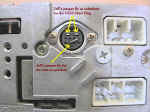 Make
the jumper wires from un-insulated 20 gauge solid wire. One for connection of
pin 1 to pin 2, and the other for connection of pin 3 to pin 4 in the radio's
CD socket. Look for small pin numbers printed on the radio's socket. Bend each
jumper wire in a "U" shape with sharp 90 degree angles to match the
spacing between the pins in the socket. The sides of the "U" forming
the pin connections should each be about 0.3 inch long. Press the U-shape
jumper wires all the way into socket's pins.
Make
the jumper wires from un-insulated 20 gauge solid wire. One for connection of
pin 1 to pin 2, and the other for connection of pin 3 to pin 4 in the radio's
CD socket. Look for small pin numbers printed on the radio's socket. Bend each
jumper wire in a "U" shape with sharp 90 degree angles to match the
spacing between the pins in the socket. The sides of the "U" forming
the pin connections should each be about 0.3 inch long. Press the U-shape
jumper wires all the way into socket's pins.
A third jumper wire should also be installed between pin
5 and pin 11 to fix or prevent that radio's common turn-on problem. For
details, see:
http://www.miata.net/garage/radio.html
Once all three jumper wires are installed cover the
radio's CD socket with a layer or two of duct tape.”
Now that the OEM radio will operate correctly with either
the Short Plug or Jeff’s above jumper fix installed, the installation is as
follows:
1. Disconnect the battery but make sure you have the radio
security code, if necessary.
2. Remove the OEM radio or the OEM radio/OEM CD player
combination.
3. If you do not have the OEM CD player and your radio is
mounted in the top position of the mounting rack, you probably have a cross
brace connecting the two sides of the rack at the bottom. You will not use this
cross brace. Disassemble the mounting rack but notice which side is left and
right and keep the proper orientation. Each side of the rack has 4 tabs bent
inward to fit corresponding slots in the radio case and the OEM CD player. You
can mount the Sony on the top or bottom but it really needs to be on top because
gear shifting would interfere with the inserting and ejecting of the CD disc.
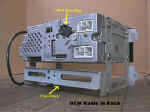


4. The Sony does not have slots cut into the case to fit
the mounting rack tabs so bend the top tabs back straight (two on each side).

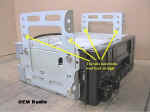
5. Mount the radio in the bottom position just like it was
in the top position.
6. The Sony comes with a face plate trim piece and a
mounting sleeve. You will not use either of these. There are several holes in
each side of the Sony, 5 of which are made to accept the Sony mounting screws in
the package. Hold the Sony in the top position of the OEM mounting rack and
align it with the radio in the bottom position. When you line up the face of
both units you will see that one forward mounting rack hole and one Sony
mounting hole line up perfectly on each side. The others do not; however, one
smaller vent hole on the Sony does line up with the slot cut in the OEM mounting
rack. You can use the Sony supplied screws for the front holes and obtain 2
large head but short screws of the proper size to fit the vent hole on each side
of player. Mount the Sony in the rack.

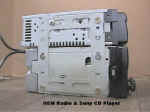
7. You can now hold the combined unit up to the Miata’s
center dash trim piece and check the fit. For me, the vertical fit was very
nice. There was not enough space between the Sony and the radio or dash trim to
even try and add filler. There is a small rectangle space on each side of the
Sony that does need some filler. Your options are open here, aluminum, plastic,
rubbing tubing or whatever floats your boat. Also, the attachment of the filler
is open; to the Sony, to the dash trim, press fit, friction, etc. Depending on
what you decide, you may want to fix this now or wait until everything is
reinstalled.
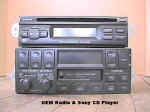
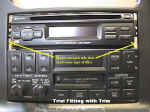
8.  At
this point I would reconnect the battery and test the car’s radio wiring
harness for the +12 volt battery and the +12 volt ignition switched wires with a
volt meter or test light to be sure I knew the correct ones, and then disconnect
the battery again. The Sony’s wiring connection has four wires, Blue, Black,
Yellow and Red. The Blue wire is for an Amp Remote In; I don’t have a separate
amplifier so I did not use this one. The Black wire is the ground and I used the
OEM ground connection on the back of the radio. The fused Yellow wire is the +12
volt battery connection so on my 1990 that is the Blue with Red striped OEM
radio harness wire. Just splice in somewhere behind the radio plug. The fused
Red wire is the ignition switched +12 volt connection and on mine that is the
Blue with Black striped OEM radio harness wire. Splice in likewise.
At
this point I would reconnect the battery and test the car’s radio wiring
harness for the +12 volt battery and the +12 volt ignition switched wires with a
volt meter or test light to be sure I knew the correct ones, and then disconnect
the battery again. The Sony’s wiring connection has four wires, Blue, Black,
Yellow and Red. The Blue wire is for an Amp Remote In; I don’t have a separate
amplifier so I did not use this one. The Black wire is the ground and I used the
OEM ground connection on the back of the radio. The fused Yellow wire is the +12
volt battery connection so on my 1990 that is the Blue with Red striped OEM
radio harness wire. Just splice in somewhere behind the radio plug. The fused
Red wire is the ignition switched +12 volt connection and on mine that is the
Blue with Black striped OEM radio harness wire. Splice in likewise.
9. The car antenna lead goes into the Sony and the Sony
antenna wire plugs into the radio. There are no other wires to hook up as the RF
modulator is internal.
10. Before securing and reinstalling everything, I would
reconnect the battery and test the system for proper operation.
11. Tie, tape or otherwise bundle and secure the wires as
necessary (there’s plenty of room in the center dash area) and reinstall
everything.

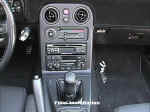
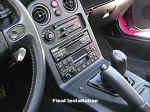
You can choose between several FM frequencies with the
Sony unit so I picked one that did not have a station and little background
noise. The Sony also has 4 different sound levels so you can pick which one
sounds best for you. The sound to me is just like the OEM player and the look is
very close to stock. The only real give away is the OEM radio labeled Panasonic
and the CD player labeled Sony.
| Back to the Garage |
21 June, 2001
|
 Make
the jumper wires from un-insulated 20 gauge solid wire. One for connection of
pin 1 to pin 2, and the other for connection of pin 3 to pin 4 in the radio's
CD socket. Look for small pin numbers printed on the radio's socket. Bend each
jumper wire in a "U" shape with sharp 90 degree angles to match the
spacing between the pins in the socket. The sides of the "U" forming
the pin connections should each be about 0.3 inch long. Press the U-shape
jumper wires all the way into socket's pins.
Make
the jumper wires from un-insulated 20 gauge solid wire. One for connection of
pin 1 to pin 2, and the other for connection of pin 3 to pin 4 in the radio's
CD socket. Look for small pin numbers printed on the radio's socket. Bend each
jumper wire in a "U" shape with sharp 90 degree angles to match the
spacing between the pins in the socket. The sides of the "U" forming
the pin connections should each be about 0.3 inch long. Press the U-shape
jumper wires all the way into socket's pins.











